load capacity AUDI A5 COUPE 2015 Owners Manual
[x] Cancel search | Manufacturer: AUDI, Model Year: 2015, Model line: A5 COUPE, Model: AUDI A5 COUPE 2015Pages: 264, PDF Size: 66.83 MB
Page 65 of 264
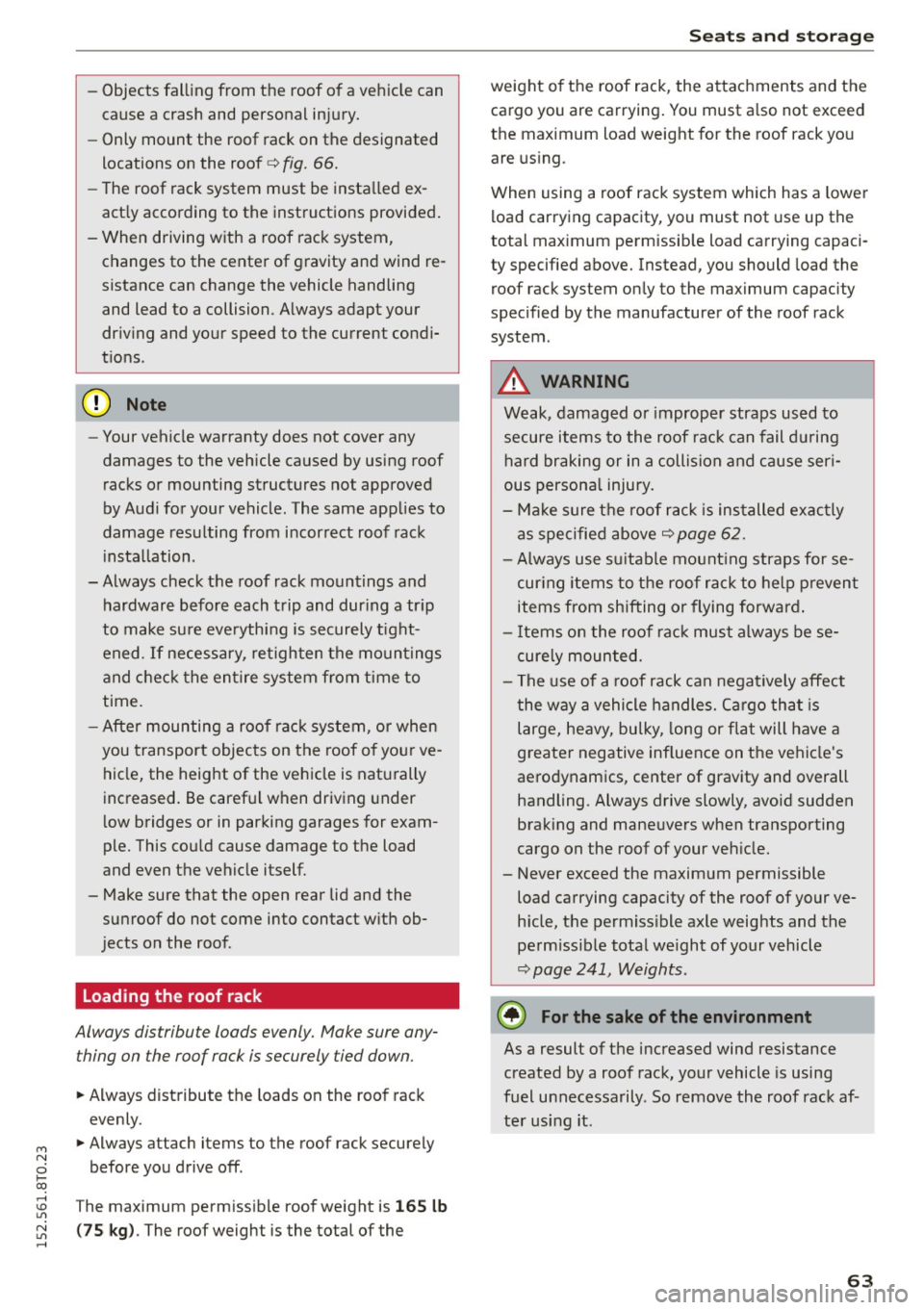
M N
i? co
-Objects fall ing from t he roof of a vehicle can
cause a crash and personal injury.
- Only mount the roof rack on the designated
locations on the roof
c> fig. 66.
- The roof rack system must be insta lled ex
act ly according to the instructions provided .
- When driving with a roof rack system,
changes to the center of g ravity and wind re
sistance can change the vehicle handling
and lead to a collision. A lways adapt your
dr iv ing and your speed to the current condi
t ions .
- Your vehicle warranty does not cover any
damages to the vehicle caused by using roof
racks or mounting structures not approved
by Aud i for your vehicle. The same applies to
damage resulting from incor rect roof rack
i nsta llation.
- Always check the roof rack mount ings and
hardware before each t rip and dur ing a tr ip
to make su re eve ryth ing is securely t ight
ened.
If necessary, re tighten the mo untings
and c he ck the en tire system from time to
time.
- After mounting a roo f rac k system, o r when
you transport objec ts on the roof of your ve
hicle, the heig ht of the vehicle is nat urally
increased. Be caref ul when driving under
l ow bridges or in parking garages for exam
ple. This cou ld cause damage to the load
and even t he vehicle itself.
- Make sure that the open rear lid and the
sunroof do not come into contact w ith ob
jects on the roof.
Loading the roof rack
Always distribute loads evenly. Make sure any thing on the roof rack is securely tied down.
~ Always dist ribute the loads on the roof rack
evenly.
~ Always attach items to the roof rack securely
before you drive
off .
~ The maximum perm iss ible roof weight is 165 lb ..,.,
~ ( 7 S kg ). The roof weight is the total of the ,....,
Seat s and stor age
weight of the roof rack, the attachments and the
cargo you are carrying . You must a lso not exceed
the max imum load weight for the roof rack you
are using.
When using a roof rack system which has a lower
load carrying capacity, you must not use up the
total max imum permissib le load carrying capaci
ty specified above. Instead, you should load the
roof rack system only to the maximum capacity
specified by the manufacturer of the roof rack
system .
A WARNING
= -Weak, damaged or improper straps used to
secure items to the roof ra ck can fail d uring
h ard braking or in a collision and cause ser i
ous persona l injury.
- Ma ke s ure t he roof rack is in stalled exac tly
as specified above
I::!) page 62.
- Always use s uitable mount ing straps for se
cur ing items to the roof rack to help p revent
items from sh ifting o r flying forwa rd .
- It ems on the roof rac k must a lways be se
cure ly moun ted.
- T he use of a roof rack can negatively affect
the w ay a vehicle handles. Ca rgo th at is
large, heavy, bu lky, long or fla t will have a
g reater negative inf luence on the vehi cle's
ae rodynamics, center of gravity and overall
handling. Always drive slowly, avoid sudden
brak ing and mane uvers when transporting
cargo on the roof of your veh icle.
- Never exceed the maxim um permissible
load carrying capacity of the roof of your ve h icle, the permiss ible axle weights and the
perm issib le tota l we ight of your vehicle
I::!) page 241, Weights .
@ For the sake of the environment
As a result of the increased wind resistance
created by a roof rack , your vehicle is using
fuel u nnecessarily . So remove the roof rack af
ter using it.
63
Page 121 of 264
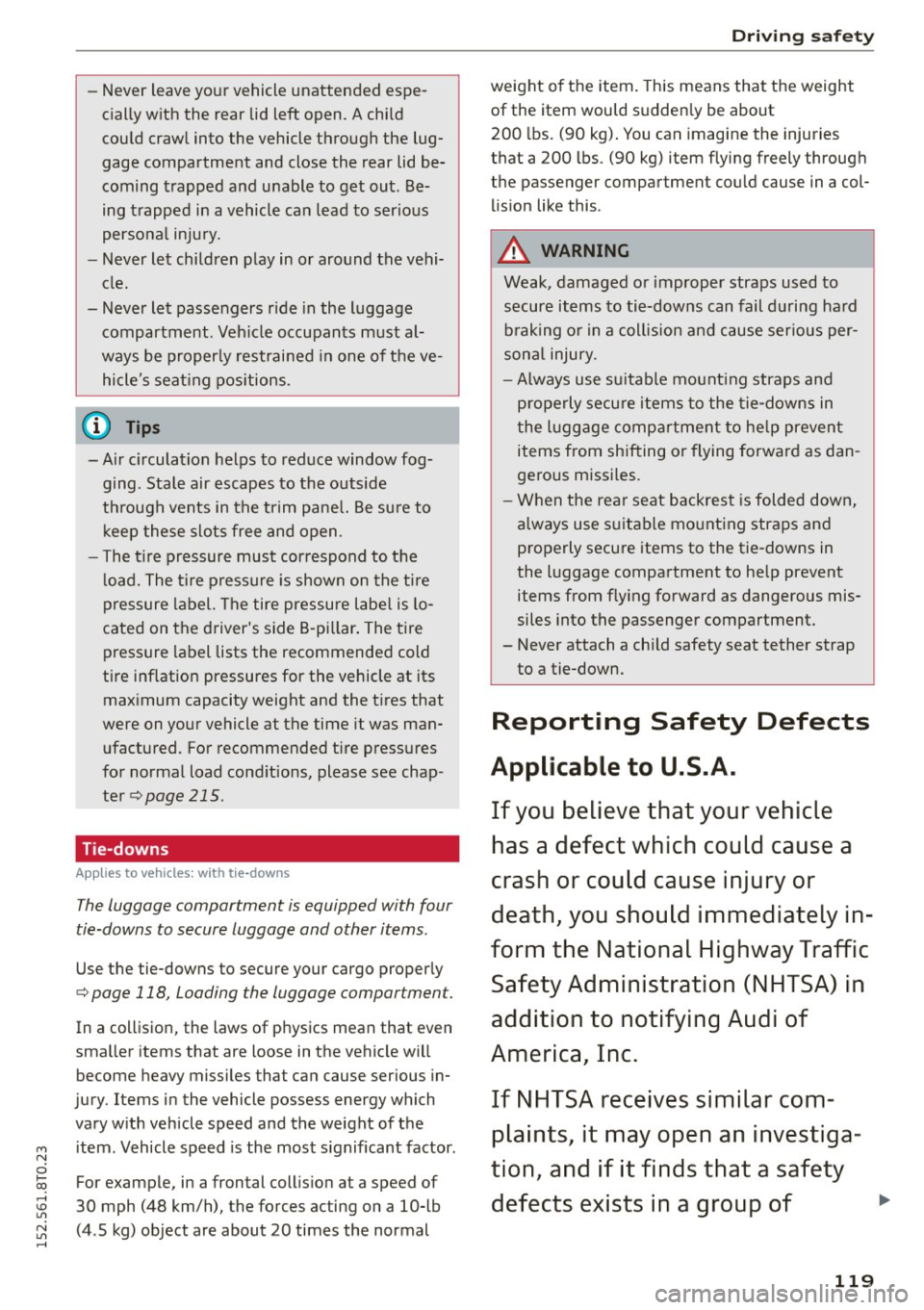
-Never leave your vehicle unattended espe
cially w ith the rear lid left open. A chi ld
could crawl into the vehicle through the lug
gage compartment and close the rear lid be
coming trapped and unable to get out . Be
ing trapped in a vehicle can lead to serious
persona l inju ry.
- Never let children play in or around the vehi
cle.
- Never let passengers r ide in the luggage
compartment . Veh icle occupants m ust al
ways be properly restrained in one of the ve
hicle's seat ing pos itions.
-Air c irculation helps to reduce window fog
ging . Stale air escapes to the outside
th rough vents in the trim pane l. Be su re to
k eep the se slots free and open.
- The t ire pressure must correspond to the
l oad. The t ire pressure is shown o n the tire
pres sure label. T he tire pressure l abe l is lo
cated on the d river 's side B-pi llar . The t ire
pressure label lists the recommended cold
tire inflation pressures for the vehicle at its
max imum capacity weight and the t ires that
were on your vehicle at the time it was man
ufactured. For recommended tire pressures
for normal load cond it ions, please see chap
te r
c:> page 215.
Tie-downs
App lies to vehicles: wit h tie-downs
The luggage compartment is equipped with four
tie-downs to secure luggage and other items .
Use the tie-downs to secure your cargo proper ly
¢ page 118, Loading the luggage compartment.
In a collision, the laws of phys ics mean that even
sma ller items that are loose in the vehicle w ill
become heavy missiles that can cause serious in
jury. Items in the vehicle possess energy which
va ry w ith vehicle speed and the weight of t he
item . Vehicle speed is the most s ignificant factor .
For example, in a frontal collis ion at a speed of
30 mph (48 km/h), the forces acting on a 10-lb
(4 .5 kg) object are about 20 times the normal
Dr ivin g s afet y
weight o f the item . This means that the weight
of the item would sudden ly be about
200 lbs. (90 kg) . You can imagine the injuries
that a 200 lbs. (90 kg) item flying freely through
the passenger compartment co uld cause in a col
li sion like this .
A WARNING
-Weak, damaged or imprope r straps used to
secure it ems to tie-downs can fail d uring ha rd
b raking o r in a coll is ion and cause seriou s per
son al injury .
- Always use s uitable mount ing straps and
p roperly se cu re i tems to the tie-downs in
the l ugg age compa rtment to he lp prevent
items from sh ifting or flying forward as dan
ge rous missi les.
- W hen the rear seat backrest is folded down,
always use s uita ble mo unting straps an d
properly secu re items to the tie-downs in
the l uggage compa rtment to he lp prevent
items from f ly ing forward as dangerous mis
siles into the passenger compartment.
- Never attach a chi ld safety seat tether strap
to a tie-down.
Reporting Safety Defects
Applicable to U.S.A.
If you belie ve that your vehicle
has a defect which could caus e a
crash or could cause injury or
death, you should immediately in
form the National Highway Traffic
Safet y Adm ini stration (NHTSA) in
addition to notifying Audi of
America, Inc.
If NHTSA re ceives simila r com
pl aint s, it may open an inve stig a
tion , and if it find s that a safety
d efe cts e xis ts in a group of ""
119
Page 208 of 264
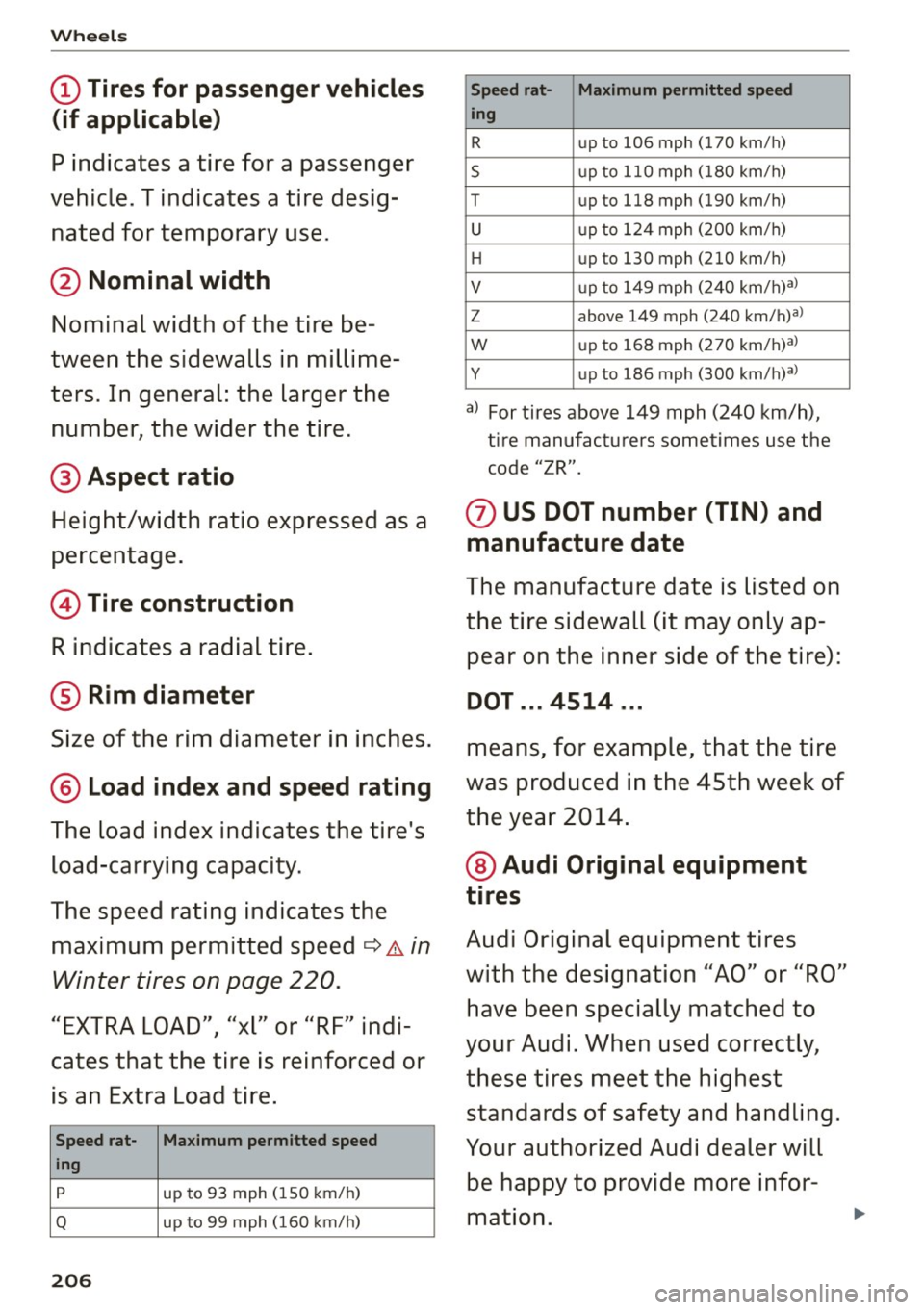
Wheels
(D Tires for passenger vehicles
(if applicable)
P indicates a tire for a passenger
vehicle. T indicates a tire desig
nated for temporary use .
@ Nominal width
Nominal width of the tire be
tween the sidewalls in millime
ters . In general: the larger the
number, the wider the tire.
@ Aspect ratio
Height/width ratio expressed as a
percentage.
@ Tire construction
R indicates a radial tire.
® Rim diameter
Size of the rim diameter in inches .
@ Load index and speed rating
The load index indicates the tire's
load-carrying capacity.
The speed rating indicates the
maximum permitted speed
¢ & in
W inter tires on page 220 .
"EXTRA LOAD", "xl" or "RF" indi
cates that the tire is reinforced or
is an Extra Load tire.
Speed rat- Maximum permitted speed
ing
p
up to 93 mph (150 km/h)
Q up to 99 mph (160 km/h)
206
Speed rat- Maximum permitted speed
Ing
R up to 106 mph (170 km/h)
s up to 110 mph (180 km/h)
T up to 118 mph (190 km/h)
u up to 124 mph (200 km/h)
H up to 130 mph (210 km/h)
V up to 149 mph (240 km/h)a>
z above 149 mph (240 km/h)a)
w up to 168 mph (270 km/h)a)
y up to 186 mph (300 km/h)a)
a) For tires above 149 mph (240 km/h),
tire manufacturers sometimes use the
code "ZR".
(J) US DOT number (TIN) and
manufacture date
The manufacture date is listed on
the tire sidewall (it may only ap
pear on the inner side of the tire) :
DOT ... 4514 ...
means , for example, that the tire
was produced in the 45th week of
the year 2014.
@ Audi Original equipment
tires
Audi Original equipment tires
with the designation "AO" or "RO"
have been specially matched to
your Audi. When used correctly,
these tires meet the highest standards of safety and handling.
Your authorized Audi dealer will
be happy to provide more infor
mation.
Page 210 of 264
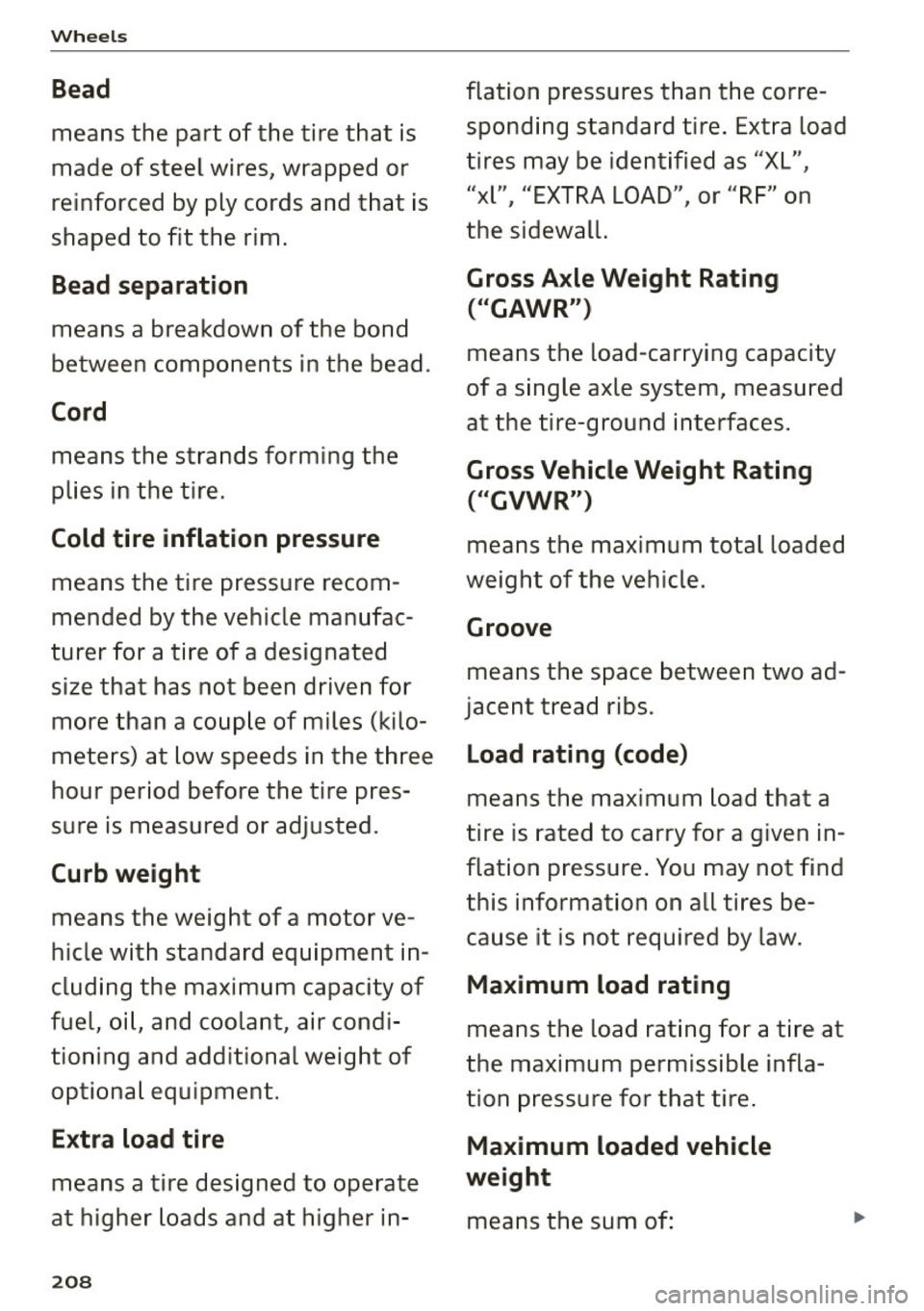
Wheels
Bead
means the part of the tire that is
made of steel wires, wrapped or
reinforced by ply cords and that is
shaped to fit the rim .
Bead separation
means a breakdown of the bond
between components in the bead.
Cord
means the strands form ing the
plies in the tire.
Cold tire inflation pressure
means the tire pressure recom
mended by the vehicle manufac
turer for a tire of a designated
size that has not been driven for
more than a coup le of miles (kilo
meters) at low speeds in the three
hour period before the tire pres
sure is measured or adjusted .
Curb weight
means the weight of a motor ve
hicle with standard equipment in
cluding the maximum capacity of
fuel, oi l, and coolant , air condi
tioning and additional weight of optional equipment.
E x tra load tire
means a tire des igned to operate
at higher loads and at higher in-
208
flation pressures than the corre
sponding standard tire . Extra load
tires may be identified as "XL",
"xl", "EXTRA LOAD", or "RF" on
the sidewall.
G ross A xle Weight Rating
("GAWR ")
means the load-carrying capacity
of a single axle system , measured
at the tire-ground interfaces .
Gross Vehicle Weight Rating
( "GVWR" )
means the max imum total loaded
weight of the vehicle .
Groove
means the space between two ad
jacent tread ribs .
Load rating (code )
means the max imum load that a
tire is rated to carry for a given in
flation pressure . You may not find
this information on all tires be cause it is not required by law.
Ma ximum load rating
means the load rating for a tire at
the maximum permissible infla
tion pressure for that tire .
Maximum loaded vehicle
w eight
means the sum of: ...
Page 211 of 264
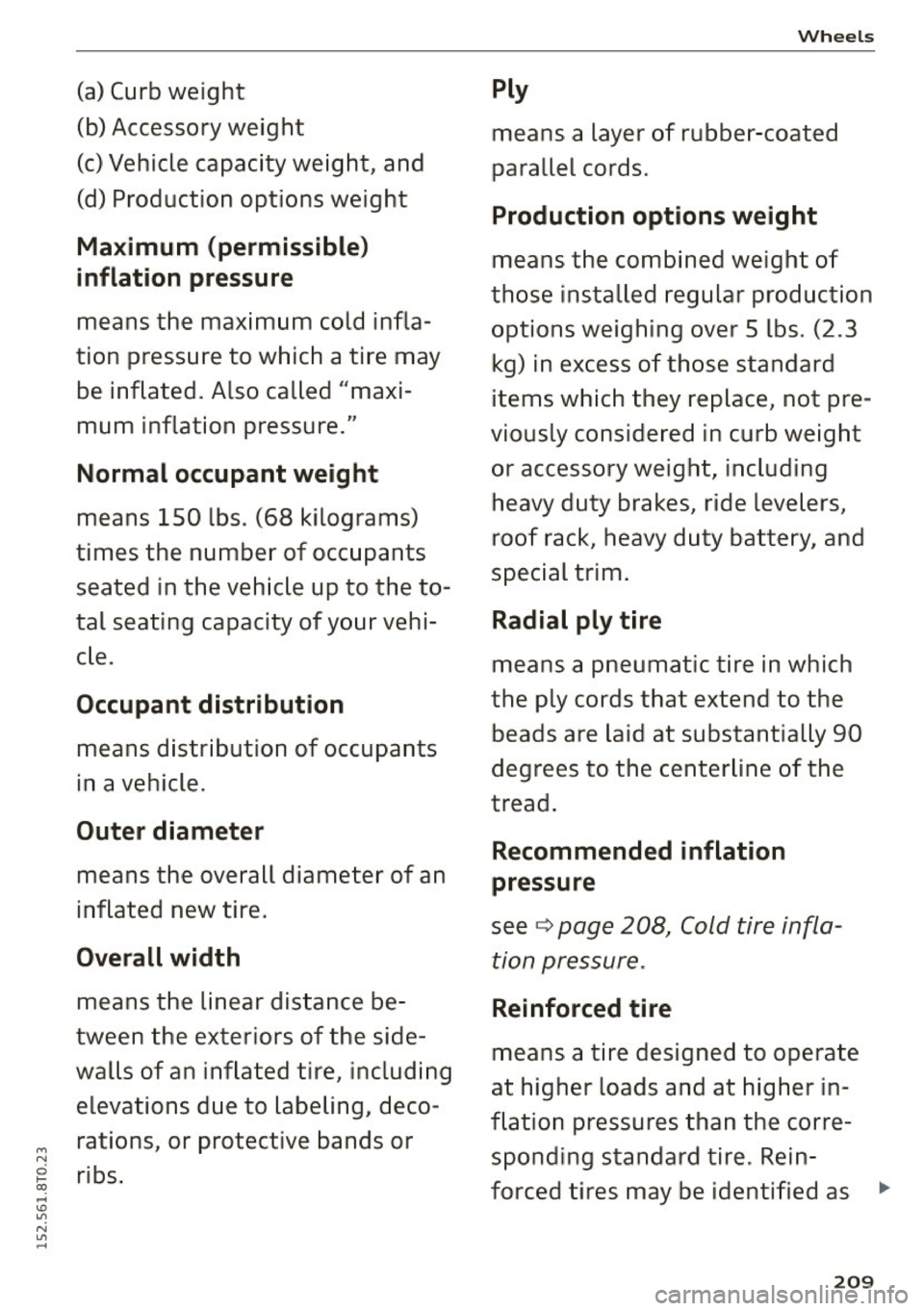
(a) Curb weight
(b) Accessory weight
(c) Vehicle capacity weight, and
(d) Product ion options weight
Maximum (permissible)
inflation pressure
means the max im um cold infla
tion pressu re to which a tire may
be inflated . Also called "ma xi
mum inflation pressure ."
Normal occupant weight
means 150 lbs . (68 kilog rams)
times the number of occupants
seated in the veh ic le up to the to
tal seating capacity of yo ur vehi
c le.
Occupant distribution
means d istr ibution of occupants
in a vehicle.
Outer diameter
means the overall diameter of an
inflated new tire .
Overall width
means the linear dis tance be
tween the exter iors of the side
walls of an inflated tire , including
elevations d ue to labe ling, deco
rations , or protective bands or
ribs .
Whee ls
Ply
means a layer of rubbe r-coated
parallel cords .
Production options weight
means the comb ined weight o f
those installed regular production
options weighing over 5 lbs . (2 .3
kg) in excess o f those s tandard
items which they re place , not pre
viously conside red in c urb weight
or accessory weight, including heavy duty brakes, ride levelers,
roof rac k, heavy d uty batte ry, and
specia l trim .
Radial ply tire
means a pneumat ic t ire in which
the ply cords that ex tend to the
beads are la id at substantially 90
degrees to the centerli ne of the
tread .
Recommended inflation
pressure
see ~ page 208, Cold tire infla
tion pressure .
Reinforced tire
means a tire designed to operate
at higher loads and at h igher in
flat ion pressures than the corre
spon ding standard tire . Rein
f orced tires may be identified as
2 0 9
Page 213 of 264
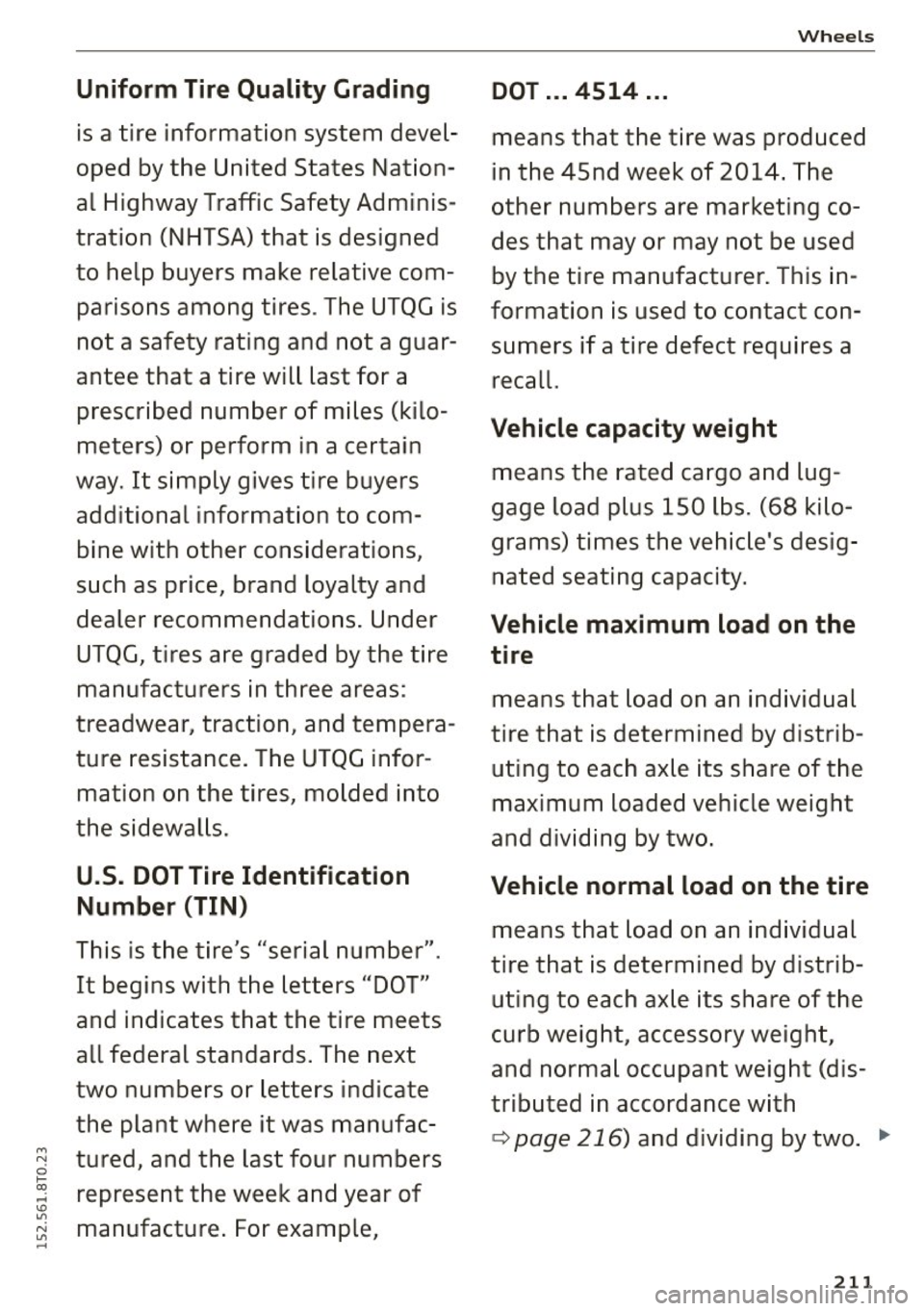
Uniform Tire Quality Grading
is a tire information system devel
oped by the United States Nat ion
al Highway Traffic Safety Adminis
tration (NHTSA) that is designed
to help buyers make relative com
parisons among tires . The UTQG is
not a safety rating and not a guar
antee tha t a tire will last for a
prescribed number of miles (ki lo
meters) or perform in a certain
way. It simply gives tire buyers
additional information to com
bine with othe r considerations,
s u ch as price , brand loyalty and
dealer recommendations . Under
UT QG,
tir es a re grade d by the tire
manu factu rers in three areas :
treadwear, traction, and tempera
ture resistance. The UTQG infor mation on the tires, mo lded into
the sidewalls .
U.S. DOT Tire Identification
Number (TIN)
This is the tire's "serial number" .
It beg ins with the letters "DOT"
and indicates that the tire meets
all federal standa rds. The next
two numbers or letters indicate
the plant where it was manufac -
;::: tu red, and the last four numbers
g
~ represent the wee k and year o f IO
~ manufacture . For example , ....
Wheels
DOT ... 4514 ...
means that the tire was produced
in the 4Snd week of 201 4. The
other numbers are ma rketing co
des that may or may not be used
by the tire manufact urer. Th is in
formation is used to contact con
sumers if a tire defect requ ires a
recall.
Vehicle capacity weight
means the rated cargo and lug
gage load plus 150 lbs. (68 kilo
grams) times the vehicle's des ig
na ted seating capacity.
Vehicle maximum load on the
tire
means that l oad on an ind iv idual
tire that is determined by distrib
ut ing to eac h ax le its share of t he
maximum loaded vehic le weight
and dividing by two.
Vehicle normal load on the tire
means that load on an individual
tire that is determined by d istrib
uting to each ax le its share of the
curb weight , accessory weight,
and norma l occupant weigh t (dis
tributed in acco rdance with
¢ page216) and dividing by two . .,.
211
Page 221 of 264
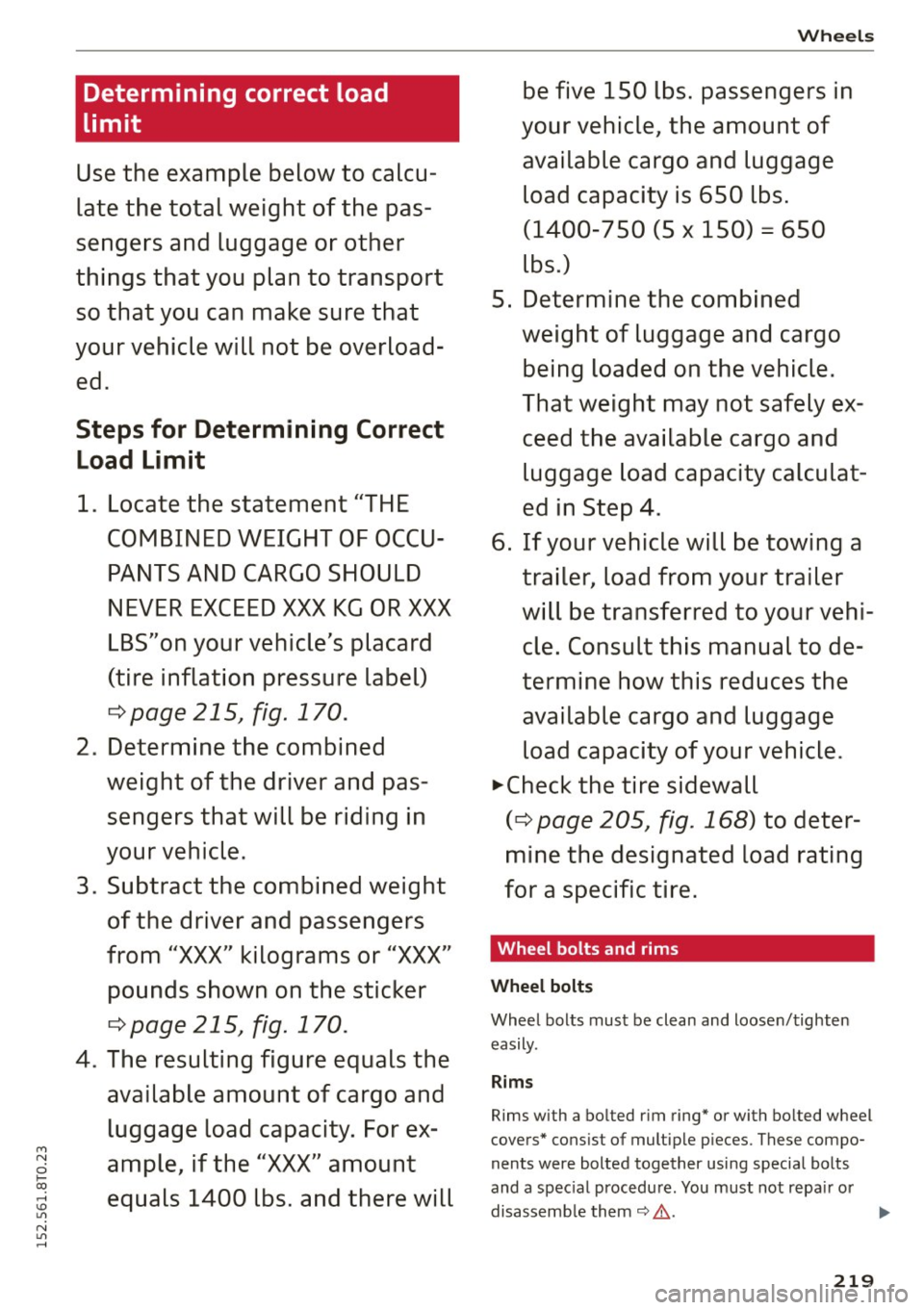
M N
i? co ,...., \!) 1.1'1
N 1.1'1 ,....,
Determining correct load
limit
Use the example below to calcu
late the total weight of the pas
sengers and luggage or other
things that you plan to transport
so that you can ma ke sure that
your vehicle will not be overload ed .
Steps for Determining Correct
Load Limit
1 . Locate the statement "THE
COMBINED WEIGHT OF OCCU PANTS AND CARGO SHOULD
NEVER EXCEED XXX KG OR XXX
LBS"on your vehi cle's pla card
(tire inflation pressure label)
¢ page 215 , fig. 170.
2 . Determine the combined
weight of the driver and pas
sengers that will be riding in
your vehicle.
3 . Subtract the combined weight
of the driver and passengers
from
"XXX " kilograms or "XXX"
pound s shown on the sticker
¢ page 215 , fig. 170 .
4. The resulting figure equals the
available amount of cargo and luggage load capacity. For ex
ample, if the
" XXX" amount
equals 1400 lbs. and there will
Wheels
be five 1 SO lb s. passenger s in
your vehicle, the amount of available cargo and luggage load capa city is 650 lb s.
(1400-750 (5 X 150) = 650
lb s.)
5. Determine the combined
weight of luggage and cargo
being loaded on the vehicle .
That weight may not safely e x
c eed the available cargo and
luggage load capa city cal culat
ed in Step 4 .
6. If your vehicle will be towing a trailer, load from your trailer
will be transferred to your vehi
cle. Con sult thi s manual to d e
termine how this redu ce s the
available cargo and luggage load capacity of your vehicle .
.,.Check the tire sidewall
(¢ page 205 , fig. 168) to deter
mine the designated load rating
for a specific tire.
Wheel bolts and rims
Wheel bolts
W heel bolts mus t be clean and loose n/tighten
easily .
Rims
Rims with a bo lted r im ring* or with bo lted wheel
cove rs* cons ist of multi ple p ieces . These compo
nents were bolted together using specia l bolts
and a spec ia l procedu re . You must not repa ir or
disassemb le th em
i::> Li::,. . ..,.
219
Page 244 of 264

Technical data
Gross Axle Weight Rating
The Gross Axle Weight Rating is the maximum load that can be appli ed at each axle of the vehi
cle ¢& .
Vehicle capacity weight The vehicle capacity we ight (max. load) is listed
on the driver's side 8 -p ill ar.
_& WARNING
- T he actual Gross Axle Weight Rating at the
front and rear axles should not exceed the
permissible weights, and their combination
must not exceed the Gross Vehicle Weight
Rating .
Dimensions
Length in (mm)
Width in (mm)
Width (across mirrors) in (mm)
Height (unloaded) al in (mm) -
Exceeding permissible weight ratings can
result in veh icle damage, acc idents and per
sonal injury.
(D Note
- The vehicle capacity weight figures apply
when the load is distributed evenly in the
vehicle (passengers and luggage). When
transporting a heavy load in the luggage
compartment, carry the load as near to the
rear axle as possible so that the vehicle 's
hand ling is not impaired .
- Do not exceed the maximum permissible
axle loads or the maximum gross vehicle
we ight. Always remember that the vehicle's
hand ling will be affected by the extra load.
T herefore, adjust your speed accordingly.
- Always observe local regulations .
AS Coupe 55 Coupe
182.1 (4626) 182 .7 (4640)
73.0 (1854) 73 .0 (1854)
7 9.5 (2020) 79 .5 (2020)
54.0 (1372) 53 .9 (1369)
al T h e he igh t of th e vehicle depend s on the tir es and t he s usp en sion .
When driving up steep ramps, on rough roads,
over curbs, etc. it is important to remember that
some parts of your vehicle, such as spo ilers or ex-
Capacities
Fuel tank: tota l capacity
Windshield and headlight* washer fluid conta iner
242
haust system components, may be close to the
ground . Be careful not to damage them.
gal (liters) 16.1 (61.0)
quarts (liters) 4
.8 (4.5)
Page 258 of 264
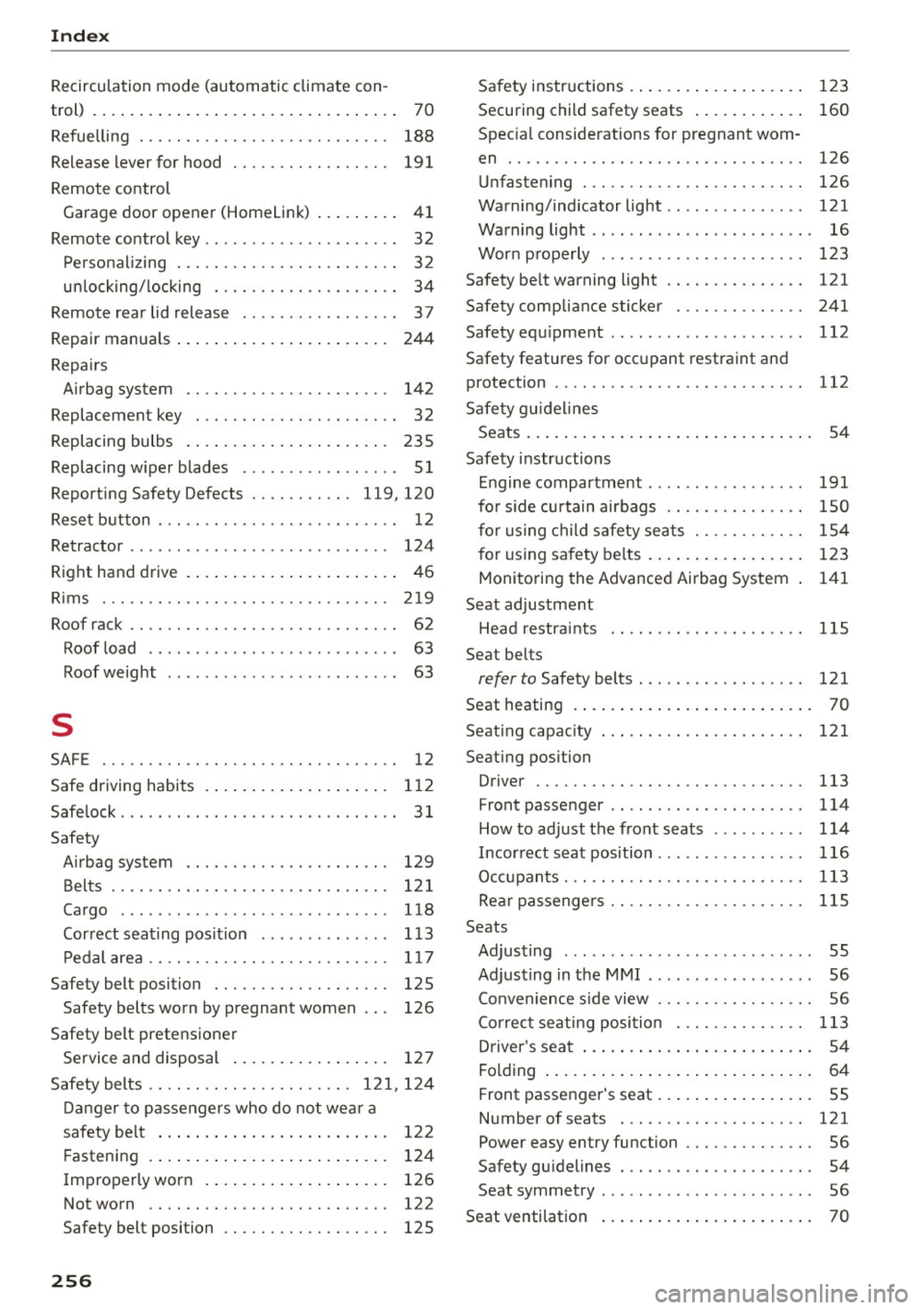
Index
Recirculation mode (automatic climate con-
trol) . . . . . . . . . . . . . . . . . . . . . . . . . . . . . . . . . 70
Refuelling . . . . . . . . . . . . . . . . . . . . . . . . . . .
188
Release lever for hood . . . . . . . . . . . . . . . . . 191
Remote control
Garage door opener (Homelink) . . . . . . . . .
41
Remote control key .......... .... ... .. . . 32
Personalizing . . . . . . . . . . . . . . . . . . . . . . . . 32
un locking/locking . . . . . . . . . . . . . . . . . . . . 34
Remote rear lid release 37
Repair manuals . . . . . . . . . . . . . . . . . . . . . . . 244
Repairs
Airbag system . . . . . . . . . . . . . . . . . . . . . .
142
Replacement key . . . . . . . . . . . . . . . . . . . . . . 32
Replacing bulbs 235
Replacing w iper blades . . . . . . . . . . . . . . . . . 51
Reporting Safety Defects . ....... .. . 119, 120
Reset button . . . . . . . . . . . . . . . . . . . . . . . . . . 12
Retractor . . . . . . . . . . . . . . . . . . . . . . . . . . . . 124
Right hand drive . . . . . . . . . . . . . . . . . . . . . . . 46
Rims
Roof rack
. . .. .. ................. .. ....
Roof load .. .. .. ... ... ... .... .. .. ... .
219
62
63
Roof weight . . . . . . . . . . . . . . . . . . . . . . . . . 63
s
SAFE . . . . . . . . . . . . . . . . . . . . . . . . . . . . . . . . 12
Safe driving habits . . . . . . . . . . . . . . . . . . . . 112
Safe lock . . . . . . . . . . . . . . . . . . . . . . . . . . . . . . 31
Safety
Airbag system .... ........... .. .. .. .
Belts
. . .. .. .. ... ... .... ..... .. .. .. .
Cargo
129
121
118
Correct seating position . . . . . . . . . . . . . . 113
Pedalarea .. .. ............... .. .. ... 117
Safety belt position . . . . . . . . . . . . . . . . . . . 125
Safety belts worn by pregnant women 126
Safety belt pretensioner
Service and disposal . . . . . . . . . . . . . . . . .
127
Safety belts .. .. ............... .. . 121, 124
Danger to passengers who do not wear a
safety belt . . . . . . . . . . . . . . . . . . . . . . . . .
122
Fastening . . . . . . . . . . . . . . . . . . . . . . . . . . 124
Improperly worn . . . . . . . . . . . . . . . . . . . . 126
Not worn ....................... ... 122
Safety belt position . . . . . . . . . . . . . . . . . . 125
256
Safety instructions . . . . . . . . . . . . . . . . . . . 123
Securing child safety seats . . . . . . . . . . . . 160
Spec ial considerations for pregnant wom-
en . . . . . . . . . . . . . . . . . . . . . . . . . . . . . . . .
126
Unfastening . . . . . . . . . . . . . . . . . . . . . . . . 126
Warning/indicator light . . . . . . . . . . . . . . . 121
w · r h arnrng 1g t . . . . . . . . . . . . . . . . . . . . . . . . 16
Worn properly . . . . . . . . . . . . . . . . . . . . . . 123
Safety belt warning light . . . . . . . . . . . . . . . 121
Safety comp liance sticker . . . . . . . . . . . . . . 241
Safety equ ipment . . . . . . . . . . . . . . . . . . . . . 112
Safety features for occupant restraint and
protection . . . . . . . . . . . . . . . . . . . . . . . . . . .
112
Safety gu idel ines
Seats . . . . . . . . . . . . . . . . . . . . . . . . . . . . . . .
54
Safety instructions
Engine compartment ................ .
191
for side curtain airbags . . . . . . . . . . . . . . . 150
for using child safety seats . . . . . . . . . . . . 154
for using safety belts . . . . . . . . . . . . . . . . . 123
Monitoring the Advanced Airbag System 141
Seat adjustment
Head restraints
Seat belt s
115
refer to Safety belts . . . . . . . . . . . . . . . . . . 121
Seat heating . . . . . . . . . . . . . . . . . . . . . . . . . . 70
Seating capacity
Seating position
121
Driver . . . . . . . . . . . . . . . . . . . . . . . . . . . . . 113
Front passenger . . . . . . . . . . . . . . . . . . . . . 114
How to adjust the front seats . . . . . . . . . . 114
Incorrect seat position . . . . . . . . . . . . . . . . 116
Occupants ... .. .. .. .. ........... .. .. 113
Rear passengers . . . . . . . . . . . . . . . . . . . . . 115
Seats
Adjusting . . . . . . . . . . . . . . . . . . . . . . . . . . .
55
Adjusting in the MMI . . . . . . . . . . . . . . . . . . 56
Convenience side view . . . . . . . . . . . . . . . . . 56
Correct seating position . . . . . . . . . . . . . . 113
Driver 's seat . . . . . . . . . . . . . . . . . . . . . . . . . 54
Fo ldi ng . . . . . . . . . . . . . . . . . . . . . . . . . . . . . 64
Front passenger's seat . . . . . . . . . . . . . . . . . 55
Number of seats . . . . . . . . . . . . . . . . . . . . 121
Power easy entry function . . . . . . . . . . . . . . 56
Safety guidelines . . . . . . . . . . . . . . . . . . . . . 54
Seat symmetry . . . . . . . . . . . . . . . . . . . . . . . 56
Seat ventilation . . . . . . . . . . . . . . . . . . . . . . . 70